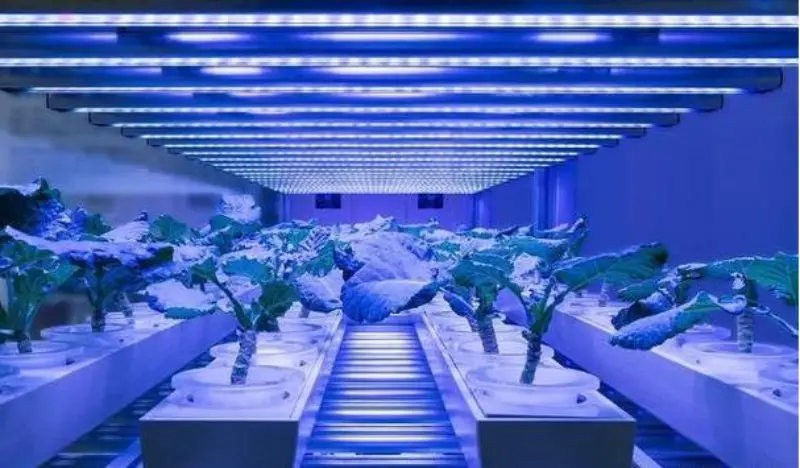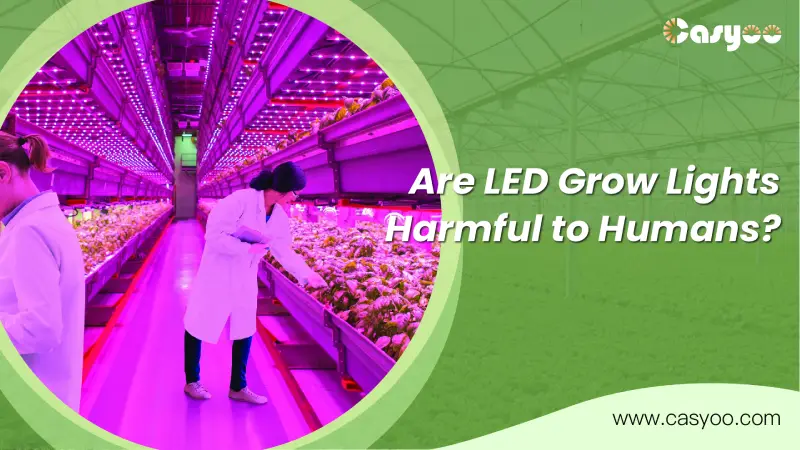LED grow light technology has greatly improved the efficiency of growing crops. Contemporary growers believe that through these lights, they can simulate sunlight with the ideal spectrum according to different plant growth stages. But some growers may ask, “Are LED grow lights harmful to humans?”
The truth is, they generally cause no harm to the human body, although in some cases it can be a health hazard, but as long as you use it correctly, it won’t hurt. This blog will explore this issue in detail.
Do LED grow lights affect your overall health?
Exposure to any type of strong light late at night can disrupt the natural sleep cycle. The body reads light as a sign that they should be awake, which can prevent people from getting a good night’s sleep at night. This is why experts recommend turning off bright light sources such as TV screens and cell phones two hours before bed. Of course, you also shouldn’t stand under a grow light before going to bed. You need to turn off the grow lights in your living area two hours before going to sleep.
Grow lighting is harmless unless it gets hot enough to burn you if you touch it. Working in an enclosed, heated space may increase the likelihood of heat stroke.
LEDs do not emit harmful radiation. Some LED lights emit mild radio frequency radiation that can interfere with wireless controllers and cell phones, but this is not harmful to humans.
Like any electrical device, LED grow lights may produce sparks. Don’t try to connect many LEDs to a single electrical outlet. Be careful to only use compatible bulbs, as mismatched electrical systems may cause electrical problems. Make sure your grow lights are far enough away from flammable items. For more details, check this blog.
Do grow lights contain harmful substances?
LED grow lights: LEDs use straight-emitting diodes and do not include any hazardous substances.
HID grow lights: HID lights are fragile and contain mercury, a hazardous heavy metal, and detrimental to human health when the bulbs break.
Fluorescent grow lights: Fluorescent tubes are filled with low-pressure argon gas or a mixture of argon-neon gas and mercury vapor. If the bulb breaks, the argon gas will leak out. T9 lamps contain higher levels of mercury, and T5 and T8 also contain small amounts of mercury.
In short, LEDs are safer and more eco-friendly.
Can LED grow lights cause eye damage?
LED grow lights imitate the natural sunlight. This is why growers find them so useful. But you should be aware that when you use grow lights indoors, you may be exposed to those unsafe lights during the day. You may need to take some measures to keep yourself safe.
But are LED grow lights harmful to your eyes? Blue light and UV rays are the most harmful to the eyes.
What effects does blue light have on humans?

Blue light damages your vision. This is because the cornea, which serves as the eye’s front protective glass, does not filter blue light from reaching the retina. Macular degeneration, another name for central vision loss, is brought on by blue light entering the retina and damaging retinal cells. Prolonged exposure to UVA light may trigger cataracts. While this is not to say that you will definitely go blind if you use LED grow lights, you should take appropriate precautions, such as using professional grow glasses to protect your eyes.
Blue light can also disrupt your sleep cycle because it can block melatonin, which helps with your sleep cycle.
What effects do UV rays have on humans?
Growers often add UV light in their growing room because it can help reduce fungi and pests. UVA light is found in grow lights, and this type of UV ray has been proven to be one of the most harmful, penetrating deepest into the skin.
Short-term overexposure to UV rays may cause sunburn. Long-term exposure to UV lights can cause damage to the DNA in skin cells, making you more susceptible to skin cancer.
UV rays are also bad for your eyes. Exposure to UV rays can cause redness, tearing, and the inability to open your eyes. Prolonged exposure to UV light can lead to cataracts and even blindness.
Are red, green, and IR light bad for humans?
Sometimes plants need specially designed grow lights of different colors to promote growth. For example, red light help with flowering and fruit development. You may have bought a full-spectrum or compound grow light that can adjust different colors of light.
In general, green and red light are not directly damaging to humans. But high-intensity light may cause eye fatigue.
Infrared light may cause thermal burns and damage our retina.
Is it safe to have a grow light in my room?
You can use grow lights in your room, but some grow lights may emit high-intensity blue light or ultraviolet light, which can be harmful. In addition, employing grow lights at night may influence melatonin secretion and disrupt our sleep cycle. Therefore, it is recommended to turn off the grow light before going to bed, or use a timer to control its working time. You also need to follow the precautions we will mention in the the next section if you want to use grow lights in your room.
What measures should be taken when using LED grow lights?
The following tips about LED grow lights apply to any lighting, not just LED lights. All of these can harm your body in some way, especially your eyes.
Keep a safe distance from your lights
It is always recommended to hang the lights at a safe distance, at least 8 feet above the ground, and to keep at least 3 feet from any UV light fixtures.
In addition, flammable materials should not be too close to the light source, otherwise there is a fire hazard.
Wear protective equipment
Wear appropriate personal protective equipment at all times when working near UV lights where 3 feet of distance cannot be maintained. This includes professional grow glasses, helmets and masks, long shirts, and pants. While in the grow room, always make sure you are completely covered, exposing as little skin as possible.
Avoid looking directly at lights
Whether high-intensity or low-intensity grow lights, prolonged exposure to such lights can cause damage to your eyes. The solution is simple, don’t look directly at the LED grow light.
The eye and mask you will wear will help you avoid damage to your face and eyes around lights.
Place the lights far enough above the plants
You may see some experts recommend at least 24-36 inches above the plants. However, other experienced farmers will tell you to put the lights 8 feet away from the crops. All in all, this depends on the intensity of your light source.
How to choose plant grow lights that are not so harmful to humans?
- Check the EN 62471 standard certification
The EN 62471 standard classifies the photobiological safety of lamps from exempt risk to high risk. We recommend that you choose lamps with exempt risk or low risk levels. You can check the lamp packaging, certification documents, or test reports to see if the product complies with the EN 62471 standard.
- Third-party laboratory certification
Some manufacturers may also supplement photobiological safety testing on the basis of third-party laboratory (such as UL) certification. You can ask them for the details.
- Pay attention to the spectrum design of plant lamps
Check the spectral range and radiation output value (W/m²) of the lamp to avoid excessive output of blue light (400-500nm) or ultraviolet light (<400nm). You can give priority to LED lamps with full spectrum or customized spectrum design. These lamps have a uniform spectrum and can reduce photobiological risks in specific spectrum.
Conclusion
LED grow lights are safer than other types of grow lights. They are safe for general use, although sometimes you need to take precautions.
At Casyoo, we are eager to answer any questions about LED grow lights to ensure the safest operation possible. So don’t hesitate to contact us!




